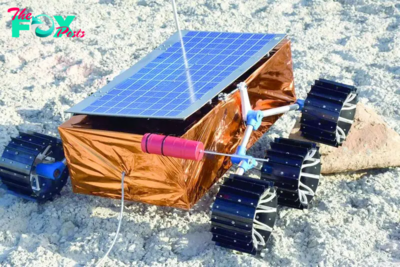Technology
Quantum compasses closer to replacing GPS after scientists squeeze key refrigerator-sized laser system onto a microchip
Researchers have taken a crucial step toward making a handheld "quantum compass" that could one day help people navigate without the Global Positioning System (GPS).
The scientists successfully miniaturized a laser system that's typically the size of a refrigerator to perform a sensing technique called atom interferometry. The system now fits onto a silicon microchip, the team reported July 10 in the journal Science Advances.
"I think it's really exciting," study lead author Ashok Kodigala, a silicon photonics scientist at Sandia National Laboratory in Albuquerque, said in a statement. "We're making a lot of progress in miniaturization for a lot of different applications."
Like light, electrons sometimes behave as waves. Atom interferometry takes advantage of this property to precisely measure acceleration, rotation and angular velocity. Those variables could help quantum compass users measure and track their own position without using GPS, which relies on continuously transmitting signals between devices and satellites.
Unlike a laser, which emits a beam of light, an atom interferometer emits a beam of super-cold atoms, and it then uses light rather than mirrors to manipulate that beam. The interferometer measures the difference in phase — whether the peaks and troughs of the waves line up with each other — between atoms on different paths. Any change in energy across the two paths, such as an atom receiving energy from an interaction with light, will shift the atoms in and out of phase. Scientists can use that to measure how fast the atoms accelerate.
Related: 'Quantum-inspired' laser computing is more effective than both supercomputing and quantum computing, startup claims
Normally, the six atom interferometers required to make a quantum compass would fill a small house. But the scientists made part of the system smaller by taking advantage of photonic integrated circuits — an existing miniature laser Technology — to build tiny modulators that can tune the beam's frequency for different functions.
-

 Technology10h ago
Technology10h agoEU fines Meta €798 million for Facebook Marketplace's 'abusive practices' | The Express Tribune
-

 Technology10h ago
Technology10h agoSpain's 'La Vanguardia' exits X, citing rise in toxic content | The Express Tribune
-

 Technology14h ago
Technology14h agoThe Gap Between Open and Closed AI Models Might Be Shrinking. Here’s Why That Matters
-

 Technology14h ago
Technology14h agoDenver Broncos on verge of giving fans faster internet as it installs Wi-Fi 6E at stadium
-

 Technology22h ago
Technology22h agoSUPARCO's rover to explore lunar surface | The Express Tribune
-

 Technology1d ago
Technology1d agoXpeng Aeroht secures 2008 pre-orders for modular flying car at Airshow China | The Express Tribune
-

 Technology1d ago
Technology1d agoAsking ChatGPT vs Googling: Can AI chatbots boost human creativity?
-

 Technology1d ago
Technology1d agoUnderstanding Retrieval-Augmented Generation (RAG): The Future of AI-Powered Information Retrieval and Response Generation



























